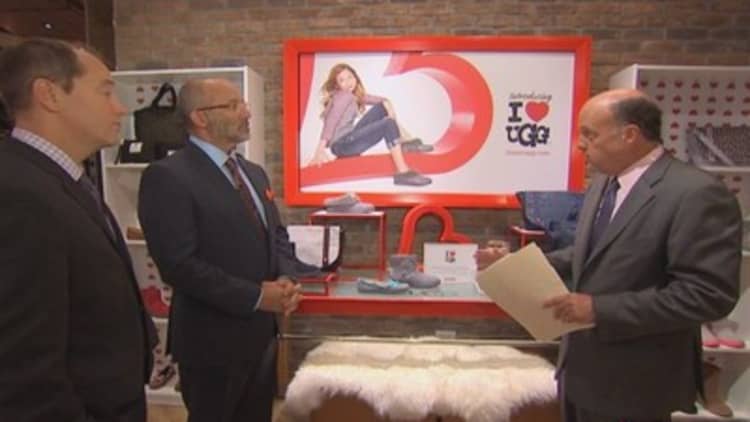Like eating too much ice cream on a hot day, or listening to your favorite song too many times in a row, sometimes it's a brand's gotta-have-it-now factor that ends up halting its growth.
It's a problem that's all too common in the retail industry.
After driving years of strength at Abercrombie & Fitch, the teen retailer said last week that its U.S. clothing will no longer bear the logos that once gave it a leg up over competitors. Once renowned for bringing a sense of luxury to the masses, overdistribution at Coach has caused sales at the leather goods company to plummet. Meanwhile Crocs, famous for its amphibious footwear, is strategizing ways to get the business back on track after seeing its stock price slashed.
Read MoreWhat's hot and what's not in fashion stocks
So how has UGG—once regarded by Wall Street as just another fad—managed to keep its brand relevant among a fickle consumer base? Angel Martinez, CEO of UGG's parent company Deckers, told CNBC it doesn't come down to chasing the latest trend. Instead, it's about focusing on comfort.
"We're not in the fashion business, per se," Martinez said in UGG's backstage lounge at New York Fashion Week. "Fashion's a component of our business but in this show here, people live and die by fashion… All of our brands deliver a functional benefit and that makes a huge difference."
The results are paying off, with company's shares rising more than 50 percent over the past year. After establishing a following for its slipper and basic boot businesses, UGG has evolved into a lifestyle brand that now includes sheepskin rugs, loungewear and handbags. It's tapped into the tween set with its I Heart UGG test line, which offers a more accessible price point between $80 and $200.
And after signing NFL quarterback Tom Brady to represent the company's men's product in 2010, the category's sales have risen 140 percent to account for 15 percent of the business—a number Martinez thinks could rise to 20 percent. Although at first some men were "poo-pooing" the idea of UGG being a men's brand, Brady's role—as well as women who bought men's slippers for their significant others—jumpstarted sales.
"We kind of signed Tom Brady to say, 'If it's OK for Tom, it's probably OK for you,' " Martinez said.
Through these initiatives and supply chain changes that made it possible to sell some lower-priced items across its footwear categories, UGG's performance in the warm-weather months of April through June helped Deckers deliver record sales "in what is historically their most seasonally challenging quarter of the year," ISI analyst Omar Saad said.
Read MoreCold weather could mean hot sales for these brands
And while UGG accounted for more than half of the company's revenue in the quarter, its smaller brands also made strides. Casual footwear brand Sanuk saw sales rise 20 percent by expanding its women's portfolio, and performance running brand Hoka will grow its presence from 650 specialty running retailers to 900 by the end of the year.
"Deckers brands are well positioned according to our eyes and commentary from major retailers," Sterne Agee analyst Sam Poser said.

Still, Deckers is not immune to the challenges facing the retail industry as a whole. For one, Martinez said it's suffered the same traffic pitfalls plaguing other retailers, as consumers switch from in-store to online shopping. For another, the company's record sales failed to deliver the brand a profit in the most recent quarter, as what Saad called its "controversial" investments contributed to a loss of $1.07 a share.
Despite these headwinds, Poser, who recently raised his price target on Deckers to $110 from $95, said he's encouraged by the company's momentum, including a move to better engage consumers by putting iPads in stores.
Read MoreModel vs buyer—who makes the most at Fashion Week
Paired with its growing retail presence, this use of technology and e-commerce have allowed the brand to communicate with consumers in a more controlled way than it was able to when it was strictly available at wholesale, Martinez said.
"The combination of e-commerce and brick-and-mortar is and will continue to strengthen the impact of the UGG brand," Poser said.
—By CNBC's Krystina Gustafson


